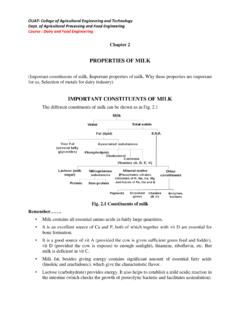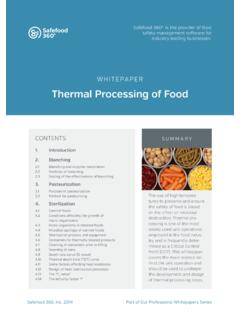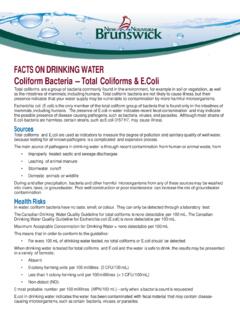Transcription of PASTEURIZATION OF MILK Objectives of pasteurization
1 College of Agricultural Engineering and Technology Dept. of Agricultural Processing and Food Engineering Course : Dairy and Food Engineering Chapter 5 PASTEURIZATION OF MILK ( Objectives of PASTEURIZATION , PASTEURIZATION requirements for milk, Methods and equipment for long hold batch type PASTEURIZATION , HTST PASTEURIZATION , UHT PASTEURIZATION ) PASTEURIZATION is the process of heating the product to a predetermined temperature and holding it until all or nearly all objectionable microorganisms, which may be present, are killed. (This was developed by Louis Pasteur, 1960) Objectives of PASTEURIZATION To make the product safe for human consumption by destroying the pathogenic organism, which may be present. Improves preservation quality by destroying almost all spoilage organisms. Helps to retain good flavor over a longer period of time. PASTEURIZATION requirements for milk PASTEURIZATION by heating and time treatments are a compromise among bacterial killing along with a number of other factors such as taste, phosphate inactivation , cream line reduction, etc.
2 The target microorganism for milk processing is Micobacterium tuberculosis (TB germ). The following Table shows how the PASTEURIZATION process has been standardized considering these factors. Accordingly, the methods of PASTEURIZATION can be given as in Table Table Standardization of PASTEURIZATION requirements for milk Requirement 30 min 15 sec Kill TB germ 138 F 158 F Phosphate inactivation 142 F 160 F PASTEURIZATION requirement 145 F (63 C) 161 F (72 C) Creamline reduction 146 F 162 F Table Methods of PASTEURIZATION for milk Methods Treatment Long hold batch type / Vat PASTEURIZATION 63 C-30 min High temperature short time (HTST) PASTEURIZATION 72 C-15 s 2 Dairy and Food Engineering- Prof. S K Dash Ultra high temperature (UHT) PASTEURIZATION 88 C-3 s However, the time and temperature combination maintained in a dairy plant may vary from the above Table values depending on the initial microbial load and other considerations.
3 LONG HOLD OR VAT PASTEURIZATION The long hold or vat PASTEURIZATION is a batch type method where the PASTEURIZATION is carried out at 63 C for 30 min. The basic operations involved in a vat pasteurizer are given in Fig. Fig. Basic operations in a vat pasteuriser Types of vat pasteurizers (Classification based on flow of heating medium) 1. Spray type 2. Flooded type 3. High velocity flooded type General requirements The following are the requirements for a successful batch PASTEURIZATION process. Rapid heating: Generally the circulation of heating medium is started as soon as filling of the vat is begun, thus shortening the heating time. Immediate cooling: In some designs the cold water is circulated over the outside of the inner lines as soon as the holding period is completed, so a part of cooling can be done in the vat itself. Heating medium should be only a few degrees warmer than milk to prevent formation of milk stones on heating surfaces and cause minimum injury to cream line or flavour.
4 Agitation. Agitation of milk within a certain degree helps in improving the heat transfer. Agitation is easier in case of hot fluid than cold ones. Agitation should not develop foam and it should not injure the cream line. Viscosity of the fluid greatly affects the type of agitator. 3 Dairy and Food Engineering- Prof. S K Dash Less viscous materials require small diameter high speed agitator. Highly viscous materials require slow speed large surface blade type agitators. Fig. Pasteurizer Controls For vat pasteurizers, an electric or air operated control can be connected with a timing clock so that the heat is shut off when the proper milk temperature has been reached and a bell rings when the proper length of holding time has elapsed. Also temperature of heating water can be controlled during the holding period. Fig. Schematic representation of a long hold batch type pasteurizer Advantages Well suited for small plants, low volume products Variety of products can be handled.
5 Well suited for cultured products such as bottle milk, sour cream, etc. Simple controls Low installation cost Disadvantages Batch type Slow process As the controls are mostly manual, it requires constant attention. Both heating and cooling are relatively expensive (as we do not have heat regeneration). 4 Dairy and Food Engineering- Prof. S K Dash HTST PASTEURIZATION High temperature short time pasteurisers are usually continuous flow systems using heat exchangers. Generally plate type heat exchangers with regenerative heating, heating and cooling systems are used. Fig. Plate heat exchanger Fig. Flow pattern in plate heat exchangers 5 Dairy and Food Engineering- Prof. S K Dash Fig. Types of plates used in plate type heat exchanger Basic components of HTST PASTEURIZATION system The HTST PASTEURIZATION process and its basic components are shown in Fig. First from a constant level tank, milk is pumped by a booster pump into a heat exchanger to heat it with the help of pasteurized milk to about 60 C.
6 As the pasteurized milk is used for heating the raw milk and there is no external heating source, we call that a regenerative heater. The regenerator reduces the actual heat requirement for PASTEURIZATION and hence is very important for the overall cost effectiveness of the system. Then the milk enters into the heater where the temperature of milk is raised to the actual PASTEURIZATION temperature. The milk then passes through the holder, where the milk temperature is maintained for the specific time so that PASTEURIZATION is completed. Then the pasteurized milk goes to the regenerator so that it gives away some heat to the raw milk. It is also simultaneously cooled so that the refrigeration requirement is reduced. After the regenerator, the pasteurized milk goes to a chiller, where the milk temperature is reduced to about 4-5 C. Fig. HTST PASTEURIZATION process 6 Dairy and Food Engineering- Prof.
7 S K Dash Fig. A HTST pasteurizer For HTST PASTEURIZATION , the following controls are very important. Flow rate Temperature Pressure Control for flow rate The flow rate is regulated by a metering or timing pump A positive displacement pump of rotary or piston type is used. Often variable speed drives are used to change the rate of flow when desired. Pump must be sized and perfectly driven such that flow rate does not exceed the actual, the holding time is not below legal minimum. Control for temperature Control of temperature includes means for maintaining a uniform product temperature at or above the legal minimum at a safe value. It should divert the flow back to the system if the temperature at the end of holder is below legal minimum. Usually a safety thermal limit recording controller is used. (It makes a continuous record of the temperature and marks the time when the flow diversion valve operates.) Control for pressure The pressure control is important in the following three sections.
8 In the regenerators In the flow diversion valve In the diverted milk lines (for homogenization, etc.) 7 Dairy and Food Engineering- Prof. S K Dash Pressure related problem in the regenerator The different causes and effects of pressure related issues in a PASTEURIZATION system are given in Fig. As it can be seen, the centrifugal booster pump takes care of the pressure related problems in the regenerator. Besides, there are three more devices as the timing pump, pressure switch and the restrictor, the functions of which are given below. Timing pump: It assures that the pasteurized product side is always under higher pressure than the raw side in the regenerator. Pressure switch: It will allow the pump to run only when the pressure in pasteurized side is at least 1 psi more than the raw side. Restrictor: It is an additional device to satisfy the minimum 1 psi difference if the cooler section does not produce enough back pressure on the pasteurized side.
9 Fig. Use of booster pump in a PASTEURIZATION system Pressure management in the flow diversion valve The thermal limit recorder not only makes a record of the temperature of the milk, but also indicates, records and controls the action of the flow diversion valve. Pressure management in diverted milk line The other pressure management is needed on the diverted milk line, since it may affect the holding time during diversion. If the holding time during diverted flow is shorter than that in forward flow, a restricting orifice should be placed in the divert line. Main parts of HTST pasteurizer Now that we have discussed the process and the controls required during the process, we can write down the main parts of HTST pasteurizer as follows. Constant level tank Regenerator Booster pump 8 Dairy and Food Engineering- Prof. S K Dash Timing pump Heater Holder Flow diversion valve Pressure switch Restricting orifice Cooler Important accessories Leak detector valves at all inlet and outlet pipes.
10 Air space heaters (Air space heating is done by introducing steam above the level of the product). Advantages of HTST PASTEURIZATION Uniform treatment. Temperature is regulated at close limits and overheating is prevented. Economical than batch systems (due to regenerative heating). Disadvantages The system is complicated. Not portable. Installation cost is more. ULTRA HIGH TEMPERATURE (UHT) PASTEURIZATION As we have discussed previously, the UHT PASTEURIZATION process involves heating the milk at a temperature of 88 C for 3 sec. The equipment is much the same as the HTST units and the controls are also similar, but the operating temperature is higher. The holder is much smaller for smaller pasteurizing time. Advantages Better texture of milk due to short holding time Greater bacterial destruction is possible. When UHT treatment is needed for greater bacterial destruction or its beneficial effect on the body and texture of ice cream, then the treatment may be given following regular PASTEURIZATION .







